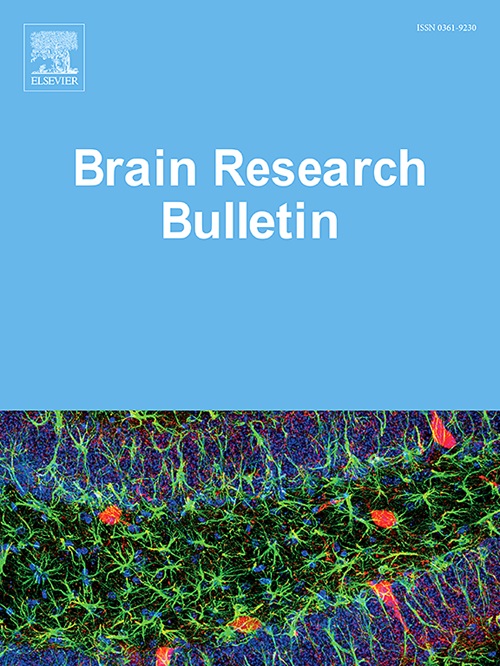学龄前儿童情绪面部焦虑的脑图绘制、生物标志物识别及机器学习诊断。
IF 3.5
3区 医学
Q2 NEUROSCIENCES
引用次数: 0
摘要
背景:由于焦虑的重要性和后果,本研究的目的是大脑制图,生物标志物鉴定和使用评估方法诊断学龄前儿童情绪面对中的焦虑。方法:45名学龄前儿童参与本研究。功能磁共振成像(fMRI)数据是在恐惧和愤怒的情况下拍摄的。采用ROI-to-ROI方法提取边缘系统的功能连通性(FC)。fMRI生物标记物(FC)作为输入特征提供给机器学习模型,以诊断儿童在愤怒和恐惧条件下的焦虑。结果:焦虑组与非焦虑组的脑图比较结果显示,愤怒状态下,大鼠内侧前额叶皮层(MPFC)与右侧杏仁核(RLA)之间的FC增加,左前海马(LAH)与左后海马(LPH)之间的FC减少。在恐惧条件下,RLA-右前海马(RAH)、MPFC-LPH和RAH- lph对区域之间的FC增加。在愤怒和恐惧条件下,可以分别使用LAH-右内侧杏仁核(RMA)和左内侧杏仁核(LMA)-RMA、LMA- rla、LMA- rah和左外侧杏仁核(LLA)- rla之间的FC来代替IQ。基于准确度、召回率、精确度和受试者工作特征曲线下面积等指标,Logistic Lasso回归模型在诊断焦虑方面优于其他模型。结论:有了这些发现,精神病学家和心理学家可以更好地了解儿童的大脑连接。本文章由计算机程序翻译,如有差异,请以英文原文为准。
Brain mapping, biomarker identification and using machine learning method for diagnosis of anxiety during emotional face in preschool children
Background
Due to the importance and the consequences of anxiety, the goals of the current study are brain mapping, biomarker identification and the use of an assessment method for diagnosis of anxiety during emotional face in preschool children.
Method
45 preschool children participated in this study. Functional Magnetic Resonance Imaging (fMRI) data were taken in fearful and angry conditions. The functional connectivity (FC) for the limbic system were extracted by ROI-to-ROI method. The fMRI biomarkers (FC) were given to machine learning models as input features to diagnose anxiety in children for angry and fearful conditions.
Result
The results of the brain mapping comparisons between anxiety and the non-anxiety showed that there was an increased FC between medial prefrontal cortex (MPFC) and right lateral amygdala (RLA) and a decreased FC between left anterior hippocampus (LAH) and left posterior hippocampus (LPH) in the angry condition. There was an increased FC between the pairs of regions, RLA- right anterior hippocampus (RAH), MPFC-LPH, and RAH-LPH in fearful condition. It is possible to use the FC between LAH- right medial amygdala (RMA) and the FC between left medial amygdala (LMA)-RMA, LMA-RLA, LMA-RAH, and left lateral amygdala (LLA)-RLA instead of IQ in angry and fearful conditions, respectively. Based on metrics such as accuracy, recall, precision, and area under the receiver operating characteristic curve, the Logistic Lasso Regression model outperformed the other model in diagnosing anxiety.
Conclusion
With these findings, psychiatrists and psychologists can have a better understanding of the brain connectivity in children.
求助全文
通过发布文献求助,成功后即可免费获取论文全文。
去求助
来源期刊

Brain Research Bulletin
医学-神经科学
CiteScore
6.90
自引率
2.60%
发文量
253
审稿时长
67 days
期刊介绍:
The Brain Research Bulletin (BRB) aims to publish novel work that advances our knowledge of molecular and cellular mechanisms that underlie neural network properties associated with behavior, cognition and other brain functions during neurodevelopment and in the adult. Although clinical research is out of the Journal''s scope, the BRB also aims to publish translation research that provides insight into biological mechanisms and processes associated with neurodegeneration mechanisms, neurological diseases and neuropsychiatric disorders. The Journal is especially interested in research using novel methodologies, such as optogenetics, multielectrode array recordings and life imaging in wild-type and genetically-modified animal models, with the goal to advance our understanding of how neurons, glia and networks function in vivo.
 求助内容:
求助内容: 应助结果提醒方式:
应助结果提醒方式:


